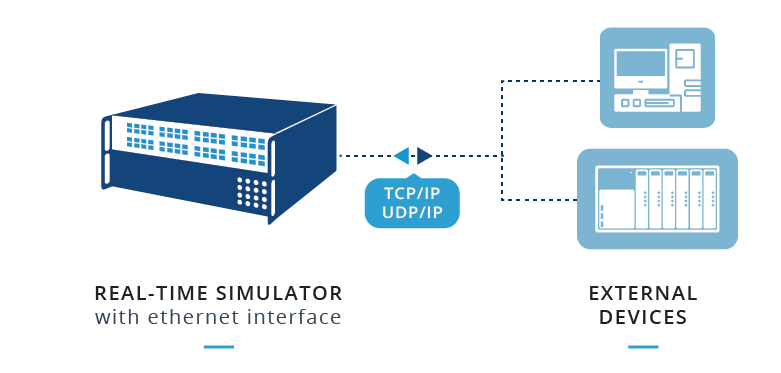Quick Nav
| Table of Contents | ||||||
|---|---|---|---|---|---|---|
|
Have a question or need help?
| Auibutton | ||||||||||||
|---|---|---|---|---|---|---|---|---|---|---|---|---|
|
Solution
| Cfm tabs page | ||||||||||||
|---|---|---|---|---|---|---|---|---|---|---|---|---|
| ||||||||||||
OPAL-RT's TCP/UDP I/O interface comes included with all Real-Time Simulators and enables the exchange of data using raw Transmission Control Protocol (TCP) streams and User Datagram Protocol (UDP) datagrams. With the proper user configuration, a driver is initialized on the target simulator at the start of the simulation and each configured TCP server will wait for a connection from a client, each configured TCP client will try to connect to the defined server, and each UDP port will begin data transmission. The driver supports multiple streams allowing exchange of data between multiple targets, applications, external equipment, etc. The format used for the data exchange is configurable by the user. This is an asynchronous driver that will not incur high-latency, allowing models to run without having to wait for transmission or reception of network frames, which typically have a non-predictable latency. |
| Cfm tabs page | ||||||||||
|---|---|---|---|---|---|---|---|---|---|---|
| ||||||||||
Transmission Control Protocol (TCP) – a connection-oriented communications protocol that facilitates the exchange of messages between computing devices in a network. It is the most common protocol in networks that use the Internet Protocol (IP); together they are sometimes referred to as TCP/IP. User Datagram Protocol (UDP) – a communications protocol that facilitates the exchange of messages between computing devices in a network. It's an alternative to the transmission control protocol (TCP). In a network that uses the Internet Protocol (IP), it is sometimes referred to as UDP/IP. |
Documentation
| Auibutton | ||||||||||||||||||||||
|---|---|---|---|---|---|---|---|---|---|---|---|---|---|---|---|---|---|---|---|---|---|---|
|
| Auibutton | ||||||||||||||||||||||
|---|---|---|---|---|---|---|---|---|---|---|---|---|---|---|---|---|---|---|---|---|---|---|
|
Product Selection guide
Since TCP/UDP interfacing comes standard with RT-LAB and HYPERSIM, no software license is required and TCP/UDP can be used with each OPAL-RT Real-Time Simulator.
Adding additional ethernet ports
If additional physical ethernet ports are required, then the following kits can be added. For applications requiring more than three (3) physical ethernet ports, the OP4510 is not recommended.
Type | Product Number(s) | Optional | Description | Simulator Compatibility | Additional requirement(s) | |||
OP4510-series | OP5600-series | OP5700-series | OP5000-series | |||||
Add-on module | OP3821 | Dual-port PCI-E X1 Gigabit Ethernet Kit for OP4510 Real-Time Simulators. Can be added if more physical ethernet ports are required for Modbus TCP. | OP4510 requires its PCIe slot to be available | |||||
Add-on module | I350T4V2BLK | Intel I350T4V2 Quad Port Ethernet Server Adapter 10/100/1000 Mbps. Can be added if more physical ethernet ports are required for Modbus TCP. | Open PCIe slot required | |||||





